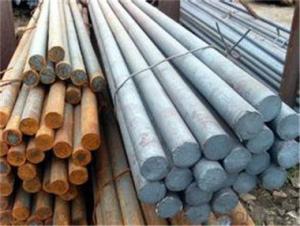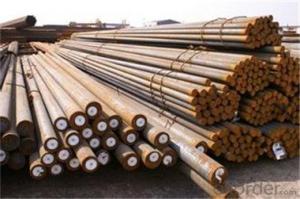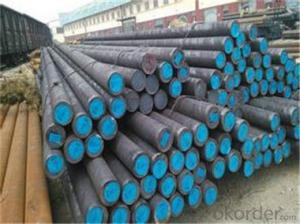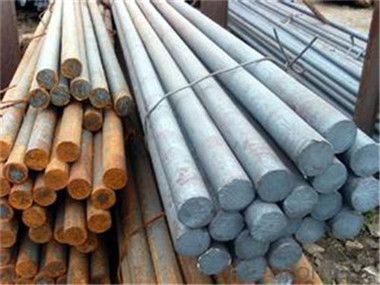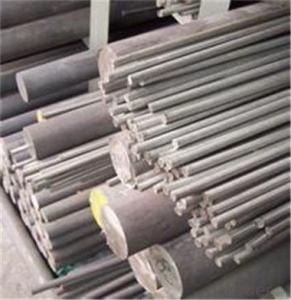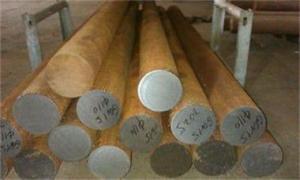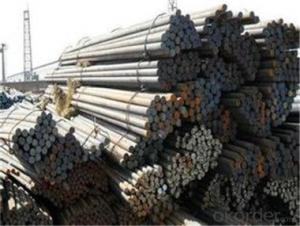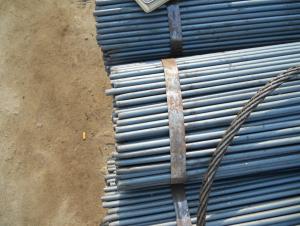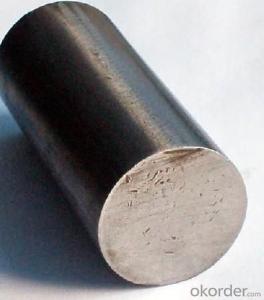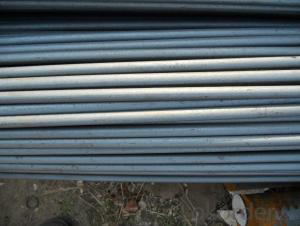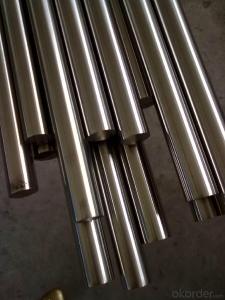Hard Chrome Carbon Steel Round Bar from China
- Loading Port:
- Tianjin
- Payment Terms:
- TT OR LC
- Min Order Qty:
- 456 m.t.
- Supply Capability:
- 2000000 m.t./month
OKorder Service Pledge
OKorder Financial Service
You Might Also Like
Description of steel round bar:
1.Diameter 80 to 800 mm
2.Black or Bright surface
3.Annealed or Quenched and tempered provided
4.Cutting service provide
Festures of steel round bar:
Dia 80-800mm Length:2000-13000mm or as required
Specifications of steel round bar:
Description |
Carbon Steel Rod/Carbon Steel Bar,carbon steel rod,carbon steel shaft,mild steel bar, mild steel shaft,ms bar | |
Material | ASTM | 1005,1006,1008,1010,1015,1020,1025,1030,1035,1040,1045,1050,1055,1060,1065,1070,1080,1084, 1016,1022 |
DIN | Ck10,Ck15,Ck22,Ck25,Ck30,Ck35,Ck40,Ck45,Ck50, 30Mn4,40Mn4 | |
BS | 040A04,095M15,045M10,080A40,045M10,080M50 | |
Standard | GB/T799,ASTM A29,A108,A321,A575,BS970,DIN1652,JIS G4051 | |
Section shape |
Round | |
Length |
As your required | |
Application | Carbon steel rod applies to chemical industry, shipping industry, manufacturing industry,construction,decorate Industry,electric power, pump shafts, sanitary wares,furniture handles,boiler,high temperature resistant,low temperature resistant, corrosion resistant. | |
Images of steel round bar:

FAQ:
1. What is your package?
Packing situation: standard seaworthy packing or as customer required.
2. How long is the lead time?
Delivery time: 45 days after order confirmed.
3. What payment term do you accept?
Payment: T/T or L/C at sight.
- Q: How do steel round bars compare to other materials in terms of strength?
- Steel round bars are known for their exceptional strength, making them highly desirable in various industries. When compared to other materials, steel round bars often outperform alternative options in terms of strength. This is mainly due to the unique properties of steel, such as its high tensile strength and toughness. In comparison to materials like aluminum or plastic, steel round bars offer superior strength and durability. Steel has a much higher tensile strength, which means it can withstand greater amounts of tension without deforming or breaking. This attribute makes steel round bars ideal for applications that require structural support or load-bearing capabilities. Furthermore, steel round bars exhibit excellent resistance to bending, shearing, and impact. This resilience allows them to withstand heavy loads, vibrations, and external forces, making them suitable for use in construction, automotive, and manufacturing industries. Steel's high strength-to-weight ratio also makes it an advantageous choice in applications where weight is a crucial factor, such as aerospace or transportation. Moreover, steel round bars can be engineered to possess specific properties, such as heat resistance or corrosion resistance, further enhancing their strength and versatility. By alloying steel with elements like chromium or nickel, it can attain resistance to rust, oxidation, and other forms of deterioration, extending its lifespan and maintaining its strength over time. In summary, steel round bars excel in terms of strength when compared to other materials. Their exceptional tensile strength, toughness, resistance to bending and impact, and ability to be tailored for specific applications make them a preferred choice in numerous industries.
- Q: How do you calculate the deflection of a steel round bar?
- To calculate the deflection of a steel round bar, you need to consider various factors such as the bar's length, diameter, and the applied load. The deflection of a bar refers to the amount it bends or flexes under a specific load. The deflection can be determined using the formula for beam deflection, which is derived from Euler-Bernoulli beam theory. The formula is as follows: δ = (F * L^3) / (48 * E * I) Where: - δ represents deflection - F is the applied load - L is the length of the bar - E is the modulus of elasticity of the steel material - I is the moment of inertia of the round bar To calculate the moment of inertia (I) for a round bar, you can use the formula: I = (π * D^4) / 64 Where: - I is the moment of inertia - D is the diameter of the round bar By substituting the values into the formula, you can calculate the deflection of the steel round bar under the given load. It is important to note that these calculations assume the bar is perfectly elastic and obeys the principles of linear elasticity.
- Q: How do you measure the hardness of a steel round bar?
- The hardness of a steel round bar can be measured using various methods, with the most common method being the Rockwell hardness test. This test involves applying a specific load to an indenter and measuring the depth of the indentation left on the material's surface. To measure the hardness of a steel round bar using the Rockwell hardness test, the following steps can be followed: 1. Select the appropriate Rockwell scale for the steel being tested. The most commonly used scales for steel are HRC (Rockwell C) and HRB (Rockwell B). 2. Clean the surface of the steel round bar to remove any dirt, oil, or contaminants that could affect the accuracy of the test. 3. Place the steel round bar on a flat and stable surface, ensuring it is properly supported to prevent any movement during testing. 4. Select the appropriate indenter for the chosen Rockwell scale. For HRC, a diamond cone indenter is typically used, while for HRB, a hardened steel ball is used. 5. Apply a preliminary minor load to the indenter, typically 10 kgf (kilogram-force) for HRC and 3 kgf for HRB. This helps ensure proper contact between the indenter and the material's surface. 6. Apply the major load, which is specific to the chosen Rockwell scale. For HRC, it is typically 150 kgf, while for HRB, it is usually 100 kgf. 7. Allow the major load to dwell for a specific period, typically 15 seconds, to ensure proper indentation. 8. Release the major load while keeping the minor load applied. This allows the indenter to partially recover, reducing the depth of the indentation. 9. Measure the depth of the remaining indentation using a microscope or a specialized Rockwell hardness testing machine. The measured value corresponds to the hardness value on the chosen Rockwell scale. It is important to note that the Rockwell hardness test is just one of several methods available to measure the hardness of a steel round bar. Other methods, such as the Brinell hardness test or the Vickers hardness test, may also be used depending on the specific requirements of the application.
- Q: What are the advantages of using shock-resistant steel round bars?
- The advantages of using shock-resistant steel round bars are that they have high strength and toughness, making them suitable for applications where there is a high risk of impact, vibrations, or sudden loadings. These bars can withstand heavy loads and absorb energy, reducing the risk of structural failure or damage. Additionally, shock-resistant steel round bars offer improved resistance to wear, corrosion, and fatigue, resulting in longer service life and reduced maintenance costs.
- Q: How do I determine the load capacity of a steel round bar?
- To ascertain the load capacity of a steel round bar, one must take into account a range of factors. The load capacity of said round bar is contingent upon its diameter, length, and the specific steel variant employed. The ensuing steps elucidate the process of determining the load capacity: 1. Ascertain the steel grade: Distinct steel grades exhibit distinct strength properties. A few examples of common steel grades are A36, A572, and 4140. To pinpoint the precise grade of the steel round bar at hand, reference the specifications or seek guidance from an engineer. 2. Calculate the cross-sectional area: Employ the formula A = πr² to compute the cross-sectional area of the round bar, with A representing the area and r representing the radius of said bar. Remember to convert the diameter to radius by dividing it by 2. 3. Determine the allowable stress: The allowable stress denotes the maximum stress that a material can endure prior to deformation or failure. This value can be gleaned from engineering handbooks or through consultation with an engineer. 4. Apply the load capacity formula: Compute the load capacity of the round bar using the formula Load Capacity = Allowable Stress × Cross-sectional Area. 5. Account for safety factors: In engineering applications, it is customary to incorporate safety factors to ensure the safety of the structure. The specific safety factors hinge upon the application in question and the desired level of reliability. To ascertain the ultimate load capacity, reference the appropriate safety factor for your project. It is crucial to acknowledge that calculating the load capacity of a steel round bar is a multifaceted procedure necessitating expertise in structural engineering. If any uncertainty arises or precise calculations are required, it is advisable to seek the guidance of a qualified engineer who can furnish detailed analysis predicated on the specific parameters of your project.
- Q: Are steel round bars suitable for the production of bearings?
- Steel round bars are unsuitable for bearing production. Bearings necessitate materials with specific properties, including high hardness, wear resistance, and a low friction coefficient. Steel round bars lack these characteristics in their raw form and would require additional processing and treatments to acquire the necessary properties for bearing production. Bearing materials are generally chosen from alloys like stainless steel, chrome steel, or ceramic materials that are designed to withstand challenging conditions and offer optimal performance.
- Q: How do steel round bars compare to rubber round bars?
- Steel round bars and rubber round bars have different properties and applications. Steel round bars are known for their strength, durability, and resistance to high temperatures and corrosion. They are commonly used in construction, manufacturing, and engineering projects that require structural support or reinforcement. On the other hand, rubber round bars are known for their flexibility, shock absorption, and noise reduction properties. They are often used in applications such as automotive parts, conveyor belts, and vibration isolation systems. Overall, the choice between steel and rubber round bars depends on the specific requirements of the application and the desired properties needed.
- Q: What is the difference between a peeled and a centerless ground steel round bar?
- A peeled steel round bar involves the removal of the outer surface to achieve a smooth and precise finish. This is typically done using a peeling machine. The purpose of this process is to eliminate any imperfections or scale on the bar's surface, resulting in a polished appearance. Additionally, the peeled round bar goes through a sizing process to ensure accurate dimensions. This makes it suitable for various applications where a smooth surface and precise dimensions are important. In contrast, a centerless ground steel round bar is achieved through the use of a centerless grinding machine. This process entails feeding the bar through grinding wheels that rotate at different speeds. Material is removed from the outer diameter of the bar to attain the desired size and surface finish. Centerless grinding offers tight tolerances and precise sizing, making it suitable for applications that demand high precision and accuracy. In summary, the primary distinction between a peeled and a centerless ground steel round bar lies in the method employed to achieve the desired surface finish and dimensional accuracy. While both processes result in a smooth and precise bar, peeling eliminates material from the outer surface, whereas centerless grinding removes material from the outer diameter. The choice between the two depends on the specific requirements of the application, as well as the desired surface finish and dimensional accuracy.
- Q: What are the different types of steel used to make round bars?
- There are various types of steel used to make round bars, including carbon steel, alloy steel, stainless steel, and tool steel.
- Q: Can steel round bars be bent or formed into shapes?
- Yes, steel round bars can be bent or formed into shapes. Steel is a highly versatile material with excellent strength and durability, making it suitable for various applications. To bend or form steel round bars, various techniques such as heating, hammering, or using specialized machinery like hydraulic presses or roll benders can be employed. These methods allow the steel bars to be shaped into curves, angles, or specific forms to meet the desired requirements. However, it is important to note that the extent to which a steel round bar can be bent or formed depends on factors such as the diameter, type of steel, and the specific bending/forming technique used.
Send your message to us
Hard Chrome Carbon Steel Round Bar from China
- Loading Port:
- Tianjin
- Payment Terms:
- TT OR LC
- Min Order Qty:
- 456 m.t.
- Supply Capability:
- 2000000 m.t./month
OKorder Service Pledge
OKorder Financial Service
Similar products
Hot products
Hot Searches
Related keywords
